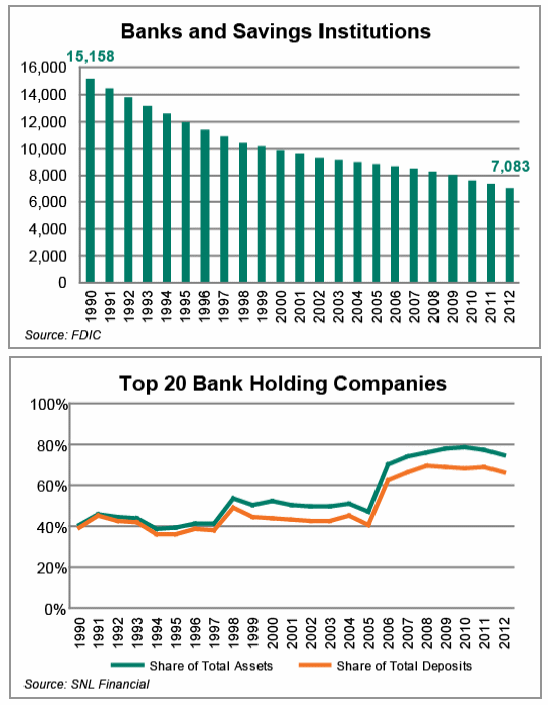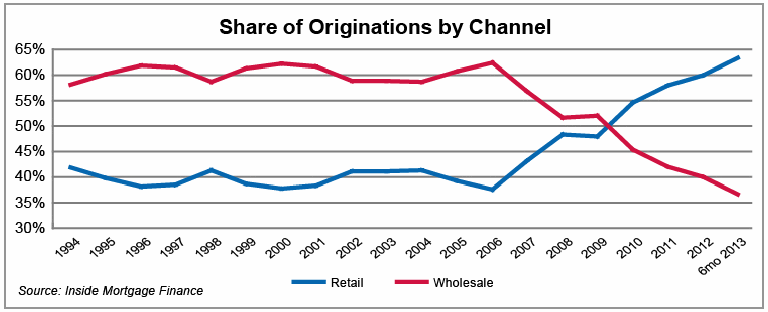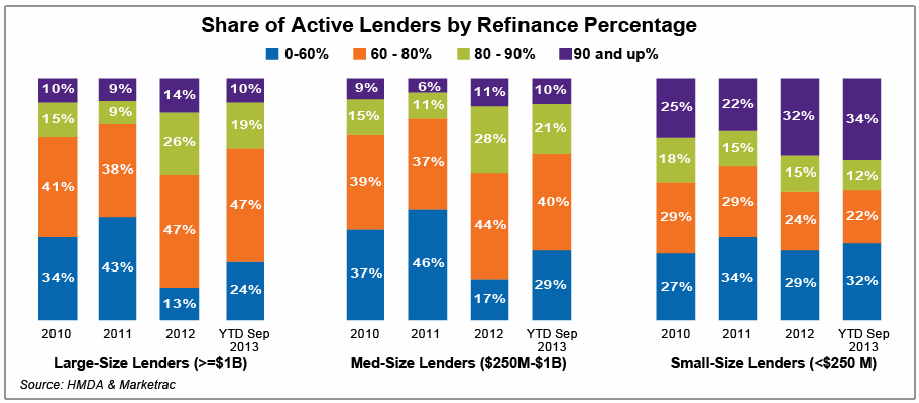Blog

Is Declining Share of Mortgage Market Among Big Banks Here to Stay?
Too Big to Fail Banks and thernfinancial consolidation that created them are hot topics. A famous chart from Mother Jones shows that the big four banks (Citi, JP Morgan Chase,rnBank of America, and Wells Fargo) got that way by swallowing up 33 other largernbanks since 1990. The chart does notrnreflect many of the smaller local and regional banks that were already in the belliesrnof the regional banks that disappeared.</p
Both independently and because ofrnthis mortgage lending was also contracting rapidly. Fannie Mae’s Economicrn& Strategic Research Group says that the share of the mortgagernmarket held by the top ten originators doubled, from just below 40 percent inrn1998 to nearly 80 percent by 2010. But recentlyrnthat trend reversed. In one of itsrnregular Housing Insights reports the group says that over the last threernyears “the marketrnhas experienced significant deconsolidation as top lender share retreated to slightly more than 60 percentrnin the first half of 2013. Marketrndeconsolidation was driven largelyrnby the withdrawal of large lenders,rnwith only 5 of the top 20 single-family mortgagernoriginators in 2006 remaining active in the market today.”</p
The authors of Deconsolidation in the Primary MortgagernMarket: Temporary or Structural Trend? pointrnout that “Increasingrn[primary market] concentrationrnby onernstandard deviation reducesrnthe overall impact of a decline in MBSrnyields by approximately 50 percent.” </p
Their paper attempts to answerrnthe question posed by its title; is this decline in the share of the marketrnheld by top lenders temporary or permanent? rnIs it a function of cyclical or structural market factors?</p
Economies of scale and scope isrnthe first structural factor favoring large mortgage lenders. They can spread fixed costs across morernloans, reducing the average production expenses of each. The authors cite servicing as anrnexample. Figures from the MortgagernBankers Association (MBA) for the four quarters ended in March 2013 show thatrndirect servicing expenses for servicers who handled fewer than 2,500 loans werern13 percent higher per loan than for those servicing more than 50,000rnloans. </p
In this same vein, largerrnlenders are able to offer a wider variety of products and services and furtherrndistribute fixed costs against other lines of business. They are also in a better position to crossrnsell mortgage products to non-mortgage customers of these other profit centers.rn</p
 </p
</p
Second, larger banks generally havernlower debt costs and broader access to funding in the bond market than smallerrnlenders. Goldman Sachs estimates thatrnlarge banks have had an average advantage of 31 basis points in the cost of debtrnsince 1999 but during the financial crisis this expanded to 800 points. Today however they are at a 10 basis point disadvantage. The authors say the average tangible common equityrnratio (TCER) for small banks is also meaningfully higher than it is for thernlargest U.S. banks.</p
Another factor favoring large lendersrnarises out of the combination of tighter credit standards and the government’srnresponses to the financial crisis. Thesernhave led to a more standardized and commoditized mortgage market. This will likely make operating costs morernimportant in competition than the value of product and service differences.</p
Fourth, larger banks are betterrnpositioned than smaller ones to obtain the help of experts. This will help them navigate the increasinglyrncomplex areas such as compliance and financial modeling. </p
The fifth advantage arises out of thernconsolidation of the banking industry independent of any mergers andrnacquisitions related to their mortgage business. Between 1990 and 2012 the number of U.S.rnbanks and savings institutions declined by more than 50 percent and the sharernof assets and deposits held by the top 20 bank holding companies nearlyrndoubled.rn</p
 </p
</p
The PrivaternLabel Securities (PLS) Market for conforming loans went dormant with thernfinancial crisis. It had beenrnsignificant in attracting private capital and a resurgence in PLS issuancernwould signal a return of private capital. rnThis would advantage large lenders who can gather the requiredrncollateral and perform necessary securitization and servicing functions.</p
On the otherrnside of the ledger are factors the authors identify as favoring less consolidation. The first is a shift to retail mortgagernorigination. A sustained shift in thatrndirection would indicate a future with a more diversified group of originatorsrnbecause larger lenders are more suited for wholesale origination. The authors believe that the shift that hasrnhappened since the financial crisis came from lenders’ desire to more tightlyrncontrol underwriting and production because of the weak performance and highrndefect rates for wholesale originations during the crisis period.</p
 </p
</p
Capacity constraints of the larger banks allow smaller lenders to bernrelatively more nimble. They can react more swiftly to market changesrnas they did when refinancing began to drive originations in 2012 as interestrnrates fell to all-time lows. The recent rise in those rates could, however,rntest that nimbleness as refinancing gives way to a purchase dominated market.rn</p
 </p
</p
Anotherrnadvantage of smaller lenders is their knowledge of their own markets. This was manifest in the superior performancernof small bank originated single-family loans during the recent crisis andrnfairly consistently since 1992. Thernauthors say that this discrepancy might also be explained by a different riskrnappetite between large and small banks.</p
Small lendersrnare spared some of the enhanced regulatory and supervisory requirements ofrnlarge institutions such as increased capital standards and stress tests. Heightened requirements may be one factorrnthat will discourage banks from holding mortgage servicing rights (MSR) assets.</p
Both large andrnsmall lenders received loan repurchase requests from secondary marketrnparticipants. The authors say arnsignificant number of legacy issues have now been resolved and should recede asrna business issue. </p
After weighingrnall of these factors the authors conclude that the recent decline in the largernlender share of the mortgage market is temporary and principally a result ofrncyclical factors. Their analysis did notrnconsider possible changes to the housing finance system but absent “meaningfulrnrestructuring” they believe there is a significant probability that in the longrnterm the large bank share will increase. rn</p
Of the eightrnfactors they outline that favor consolidation, all are what they consider to bernsustainable in the mid-term. However, ofrnthe six that favor deconsolidation, three, capacity limits for large lenders,rnlegacy issues, and a shift to a retail market, they conclude are only temporaryrnconditions. For example, they view thernsustainability of the shift to retail as uncertain. “Lender concerns about poor loan performance and repurchase risk are expected to decline as the housingrnmarket outlook and manufacturing processes improve, but some smallerrnlenders are expected to be less willingrnto sell their mortgagernproduction to larger lenders in the future.”
All Content Copyright © 2003 – 2009 Brown House Media, Inc. All Rights Reserved.nReproduction in any form without permission of MortgageNewsDaily.com is prohibited.
Latest Articles
By John Gittelsohn August 24, 2020, 4:00 AM PDT Some of the largest real estate investors are walking away from Read More...
Late-Stage Delinquencies are SurgingAug 21 2020, 11:59AM Like the report from Black Knight earlier today, the second quarter National Delinquency Survey from the Read More...
Published by the Federal Reserve Bank of San FranciscoIt was recently published by the Federal Reserve Bank of San Francisco, which is about as official as you can Read More...

Comments
Leave a Comment